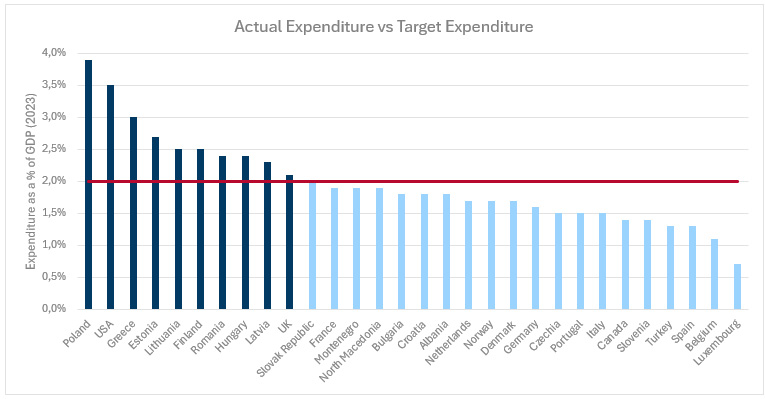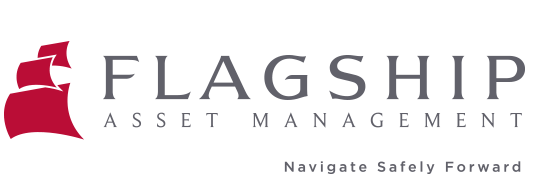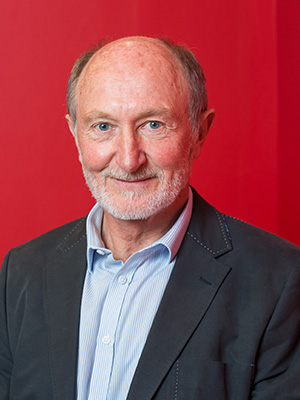
18 Mar Defence battle lines are drawn across Europe
As published in Business Day on 18 March 2024
By Portfolio Manager, JD Hayward
Writing about peace and war can be a delicate subject. While the past few decades have been relatively peaceful across most of the developed world, many developing countries have not enjoyed a similar era of calm. The Middle East and Africa have been particularly hard hit, with both experiencing bouts of conflict over a prolonged period.
Today, however, much of the developed world is again facing the prospect of war. While the battle for Ukraine is by far the most dangerous in terms of the risk of spilling over into a far larger conflict, it is by no means an isolated incident. According to the Geneva Academy of International Law and Human Rights, there are currently more than 100 instances of armed conflict, both internal and cross-border, worldwide.
There are also several situations where tensions are simmering below the surface. Front and center would be Beijing and its increasingly aggressive rhetoric towards Taiwan, together with its disputed claims over the South China Sea.
While most of these conflicts are unlikely to spill over into large scale warfare, there is no looking past the fact that, today, the world is again facing the prospect of confrontation between nuclear-armed superpowers, with Russia’ President Vladimir Putin warning, as recently as 2 weeks ago, that its nuclear forces are in “full readiness”.
Structural Underinvestment
Since the end of the cold war, the West has experienced an era referred to as the “Long peace”. Increased globalization in terms of trade and mutual commercial goals is a primary factor. There is also the relatively strong deterrent of nuclear war and virtually assured mutual destruction, which has helped ensure peace over the past 8 decades. After all, mutual destruction does not sound like a lot of fun.
This might have instilled a false sense of security in many countries, swiftly exposed when regional powers had to start delivering aid to Ukraine. The thought of a largescale ground war had become so distant that many members of NATO realized that they were not that well equipped to fight one.
To ensure it is sufficiently armed to come to the defence of members when required, NATO put spending guidelines in place: 2% of each country’s respective GDP. The rationale makes sense. Countries with stronger economies would contribute a larger nominal amount, but proportionally the contributions would be fair. The problem is that only 3 members met the contribution requirements in 2014, despite NATO Defence Ministers pledging more contributions as far back as 2006.
The year 2014 proved to be a pivotal year in NATO’s history, as the “Long Peace” abruptly halted when Russia illegally annexed the Crimean Peninsula. Understandably, this served as a wake-up call. Two years later there came another wake-up call, by the name of Donald Trump.
After Trump was elected US President in 2016, and thus Commander-in-Chief of NATO’s most powerful member, he gave a thorough dressing down to the NATO countries who were not footing their share of the defence bill. The United States, by far the most powerful of all the NATO allies, was carrying the bulk of NATO’s funding burden. This did not make “the Donald” very happy. This is all relevant as it is now clear that the 2024 US Presidential Election will be a Biden-Trump rematch. If Trump is re-elected, there is likely to be increased pressure on NATO members that are not yet paying their dues.
Increased Defence Spend
The results of Russia’s invasion, combined with Trump’s hardline stance, have been noteworthy. While only 3 NATO members reached the target spend level in 2014, this increased to an expected 18 countries in 2024 – an improvement, yet a lot of investment still needs to be made. After the ascension of Finland in 2023 and Sweden last month to become fully fledged members, NATO now has 32 member states, more than 40% of which will not have met their spending targets.

While the accompanying bar chart gives the impression that the US is not that far ahead of peers in terms of military expenditure, the pie chart below provides a different perspective.

Investment Implications
As grim as the prospect of war is, and as much as military and defence investments have traditionally been viewed in a poor light from an ESG perspective, they remain relevant and necessary in protecting the fabric of society. Exposure to the structural growth story behind this theme can come in different forms. One can either invest in traditional arms manufacturers (Germany’s Rheinmetall or Britain’s BAE Systems) or take a more subtle approach by investing in auxiliary services, such as radar and electronic systems, German listed Hensoldt or French listed Thales. There is the option to invest in companies that have segmental exposure to the industry, without being dependent on it, such as Airbus or Rolls Royce. Both are familiar names in the commercial aerospace industry, but also have significant defence operations. All of these companies have experienced, and should continue to experience, increased military spending supported by a world simmering in geopolitical tension.
The past year has delivered stellar returns for global equities. Once markets inevitably cool down, and the effect of high borrowing costs starts to bite, investors will have to look outside of the well-trodden IT sector for opportunities. This becomes easier when considering investment opportunities outside of South Africa, which are set to benefit from structural tailwinds, even in times of geopolitical tensions and uncertainty.
About the author
James Hayward BEng (Civil) CFA
Fund Manager
James, JD, is a fund manager of Flagship’s global funds, having joined in 2021 as an equity analyst. At the completion of his degree, JD worked in the engineering and fintech start-up industries while pursuing further studies in investments. JD holds an Engineering degree from Stellenbosch University and is a CFA charter holder.


















